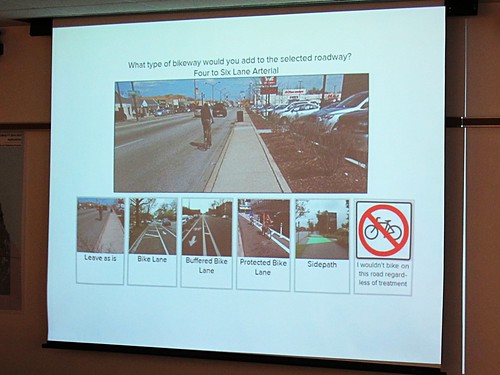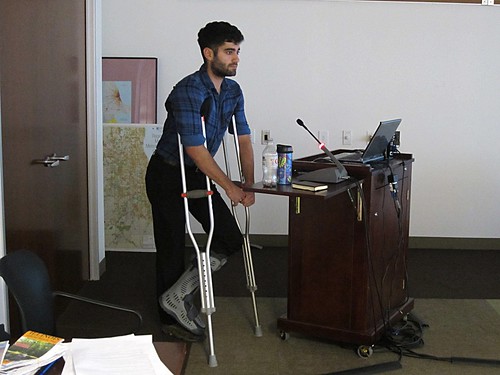As the Illinois Department of Transportation launches the public input process for the state’s first-ever statewide bicycle transportation plan, the elephant in the room is IDOT’s prohibition of protected bike lanes on state jurisdiction roads in Chicago. Protected lanes have been proven to improve safety for all road users, based on several years worth of data in other American cities like New York, which has been installing them since 2007.
However, this winter Steven Vance reported that IDOT is blocking the Chicago Department of Transportation from installing protected lanes on state roads within the city, at least until CDOT provides three years of safety data on other local protected lanes, which won’t be possible until July 2014. It’s ironic that IDOT is seeking input on strategies for improving bike safety when the department’s own policy is undermining it.
If you’re reading this on Tuesday afternoon, please consider attending the public meeting from 6:30-8 p.m. today at the Jim Thompson Center, 100 West Randolph in the concourse assembly room, and voicing your displeasure with IDOT’s protected bike lane policy. If you can’t attend, you can also give the state a piece of your mind via an online survey for the bike plan. You can also join an online “webinar” on Tuesday, July 30, 6:30-8:00 p.m. RSVP for the webinar here. Several other public meetings will held downstate this month.
During an input meeting for transportation professionals earlier this afternoon at the Chicago Metropolitan Agency for Planning offices, staff from Alta Planning and Design, consultants for the state bike plan, walked attendees through surveys on what kind of bike improvements they’d like to see. It’s worth noting that protected bike lanes are mentioned in these handouts, and discussed as a possibility by the Alta consultants.
After the floor was opened to questions, I brought up the subject of the protected bike lane ban. Here’s a transcript of the conversation:
John Greenfield: Stop me if this isn’t the right place to bring this up, but IDOT currently has a policy of prohibiting protected bike lanes on state roads. Will the public input process for the state bike plan have any effect on whether IDOT will eventually embrace protected bike lanes? The currently policy is, they’re waiting for at least three years of safety data on protected bike lanes in Chicago.
IDOT Bicycle & Pedestrian Policy Advisor Gabriel Sulkes: I can say that this plan and Alta will produce recommendations along a variety of different metrics, as we’ve seen, including design recommendations. And concurrent to the state bike plan study, there’s a District 1 [Chicago region] study over the next few years also looking at innovative design treatments, ways to best accommodate bikes and pedestrians in this district.
All these plans will produce recommendations that the department will take into consideration when designing facilities and when looking at internal policies. I think something that Alta has emphasized is that this plan will not produce a document that is implemented policy change. It will produce a roadmap for IDOT’s future in terms of changing policies and evaluating the recommendations that are produced in both the statewide study and the District 1 study.
So what’s helpful about this kind of process is coming to meetings like this and soliciting feedback and hearing from constituents and residents the types of recommendations and the types of facilities that they would like to see so that when we do evaluate these plans we can find ways to implement those.
Alta Chicago Office Director Craig Williams: As I had mentioned earlier, we’ve identified those treatments that currently aren’t in the [IDOT] Design & Environment Manual, which, along with the [IDOT Bureau of Local] Roads Manual, is kind of the bible that engineers and IDOT staff and municipalities use to determine the standards of design. The idea is to point out those elements that aren’t in there and to hopefully encourage them to include more of those. Certainly there are things like buffered bike lanes that are pretty easy to implement. A broader use of even regular bike lanes would be encouraged in a lot of facilities.
I have to say that District 1 is unique. I didn’t mention this in the beginning, but I was the bicycle and pedestrian coordinator for IDOT for about ten years and I can say that 80 to 90 percent of the bike facilities in the state are here. 98 percent of the enthusiasm for bike facilities is here. When we go downstate, we won’t get the same questions that you’re asking today. I doubt that we’ll get a protected bike lane question in District 5 [which includes Carbondale] or District 7 [which includes Effingham]. There we’re hopeful if we can get support for paved shoulders or sharrows or just simple bike lanes. It’s a really different part of the state.
[A participant asked a question about whether the plan will also address pedestrian issues; Williams said ped facilities are relevant to the plan, but not part of its focus.]
[Unidentified participant]: This is kind of relating to one of the earlier questions. I’m seeing a lot on [the survey] about how IDOT can implement different policies and provide more information. I’m not seeing a lot about how IDOT can just get out of the way [laughter from the audience] and let some communities, particularly the city of Chicago, do things to make biking safer and easier. I don’t know if there’s a commitment to bike safety from IDOT, but I think that there’s a perception on the part of the cycling community here that [there isn’t]. So I don’t know if there’s anything that can be done about that on a survey like this.
CW: It’s a very good comment and we’ll certainly note it.








